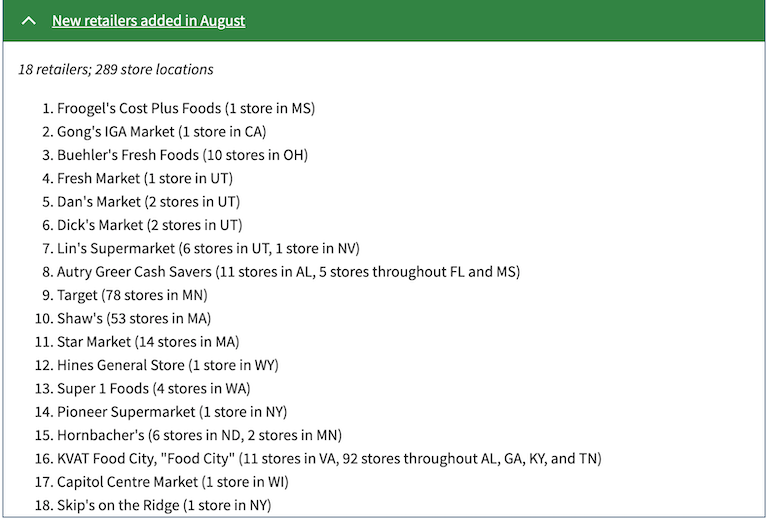The summer season saw the U.S. Department of Agriculture significantly expand the base of grocery retailers authorized to offer online shopping to recipients of Supplemental Nutrition Assistance Program (SNAP) benefits.
USDA said this week that 150 additional retail grocery chains are now offering online shopping to SNAP participants, representing thousands of actual stores. In collaboration with state agency and vendor partners, the department has expanded the availability of SNAP online purchasing to 49 states and the District of Columbia, providing more than 99% of all SNAP benefit recipients with access to online food shopping and purchases.
During June, July and August, 35 grocery retailers accounting for a combined 723 stores across the country launched SNAP online grocery shopping, including 289 stores from 18 retailers in August alone. Those additions built on an even stronger May, when nine grocers representing 517 stores joined the program, for a total of 1,240 new SNAP online locations from 44 retailers over four months.

“Online grocery shopping is a convenient, safe, secure, way to shop for food while saving SNAP participants time and money,” said Stacy Dean, Deputy Under Secretary for Food, Nutrition, and Consumer Services. “Expanding the diversity of our online shopping retailers is a critical component of our nutrition security goal to provide better access to healthy, safe, affordable foods.”
Among the new retailers authorized for SNAP online grocery purchases in August were K-VA-T’s Food City (11 stores in Virginia and 92 stores in Alabama, Georgia, Kentucky and Tennessee), Target (78 stores in Minnesota), Shaw’s (53 stores in Massachusetts), Star Market (14 stores in Massachusetts), Autry Greer Cash Savers (11 stores in Alabama and five stores in Florida and Mississippi), Buehler’s Fresh Foods (10 stores in Ohio), Hornbacher’s (six stores in North Dakota and two stores in Minnesota), Lin’s Supermarket (six stores in and one store in Nevada) and Super 1 Foods (four stores in Washington).
USDA noted that just over 3 million SNAP households shopped online as of July, which it called “a substantial increase” from March 2020, when approximately 35,000 SNAP households did so. The department said it’s actively providing technical assistance to all stakeholders interested in offering SNAP online purchasing to diversify the base of authorized grocers, namely smaller, independent supermarkets.
Also in July, USDA announced a $5 million competitive grant to help expand the number of retailers for SNAP online purchasing. Known as the SNAP EBT Modernization Technical Assistance Center grant, the program will fund an organization to provide “extensive support” to retailers with the technology and systems necessary to enable SNAP e-commerce. The grant is funded by the American Rescue Plan stimulus legislation enacted last year.
Under the SNAP Online Purchasing Pilot, launched by the USDA’s Food Nutrition Service (FNS) in April 2019, 49 states (except Alaska) and the District of Columbia now allow SNAP beneficiaries to shop and pay for groceries online. Amazon, Walmart and Aldi are the only grocery retailers enabling SNAP online grocery shopping on a national scale. A number of chains, as well as Amazon, also accept SNAP EBT payments for online grocery orders, including through Instacart.
The USDA said it’s also developing a pilot to allow SNAP consumers to use their smartphones to buy groceries at the checkout counter and will soon seek states to participate in the program. The goal is enable SNAP participants to input their EBT card into a mobile device and make SNAP purchases at the point-of-sale without the presence of the card.
SNAP online purchasing stems from the 2014 Farm Bill, which authorized the USDA to test online purchasing for recipients before rolling it out nationally. FNS, which administers SNAP, issued a call for retailer volunteers for the pilot in September 2016 and then in January 2017 offered participation in the initiative’s first phase to Amazon, Walmart, ShopRite, Safeway, Hy-Vee, FreshDirect, Dash’s Market and Wright’s Markets.


